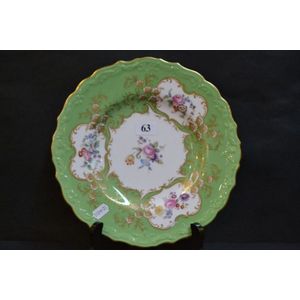Longton Hall Strawberry Leaf Plate, 1751-60
You must be a subscriber, and be logged in to view price and dealer details.
Subscribe Now to view actual auction price for this item
When you subscribe, you have the option of setting the currency in which to display prices to $Au, $US, $NZ or Stg.
- Circa - A Latin term meaning 'about', often used in the antique trade to give an approximate date for the piece, usually considered to be five years on either side of the circa year. Thus, circa 1900 means the piece was made about 1900, probably between 1895 and 1905. The expression is sometimes abbreviated to c.1900.
- Deutsche Blumen - Deutsche blumen is a German term which translates to "German flowers." It is a decorative art style that emerged in Germany in the late 18th and early 19th centuries. The style is characterized by a profusion of highly detailed and lifelike flowers, fruits, and leaves, typically arranged in bouquets or garlands.
The style was particularly popular in the manufacture of porcelain, with many German porcelain factories producing pieces in the style. These pieces were often used for table settings, and were highly prized for their beauty and craftsmanship.
Deutsche blumen was a reaction against the ornamental austerity of the previous rococo and empire styles, and was a reflection of the growing interest in naturalism and botanical illustration during the 19th century. The style is considered to be a precursor of the Art Nouveau movement, which emerged later in the century. - Soft Paste Porcelain - Porcelain is an ancient ceramic material, first made in China, hence the common name "china", and the process was unknown in the West.
European potters attempted to replicate Chinese porcelain, without knowing the ingredients in its composition, and the earliest wares were produced with mixtures of clay and ground-up glass (frit), the idea being that the glass would give the porcelain translucency.
It was given the name "soft" because it did not remain rigid, but "slumped" when fired in the kiln at high temperatures. - Emeralds - Emeralds have been used in jewellery making for thousands of years, and are prized for their deep green colour, which is caused by the presence of chromium and vanadium in the mineral beryl. Because of their rare colour, emeralds are often more valuable than diamonds of a similar size and quality. In jewellery making, emeralds are typically cut into round or oval shapes to maximize their color and clarity. They are often set in gold or platinum and used as the centrepiece of a piece of jewellery, such as a ring or necklace. They can also be used in combination with other gems, such as diamonds, to create intricate and beautiful designs.
This item has been included into following indexes:
Visually similar items

A Chamberlain's Worcester soup plate, 1847-1850 period, with a moulded scalloped border beautifully enamel decorated with a spray of wild rose, sprigs of forget-me-nots and other flowers, and four butterflies; impressed mark underside and partial red regis

A Flight, Barr & Barr Worcester porcelain rose plate, circa 1813, with decoration by probably William Billingsley, a lobed dish with gadrooned edges, sprigged with pink roses, blue bells and forget-me-nots; impressed mark and backstamp of 1813-40 period; B

A small bow porcelain works plate, 1760-1776 period, the lobed plate with a gilt dentil border, scattered with Deutsche Blumen, diameter 17.5 cm

Spode Copeland plate, green ground
